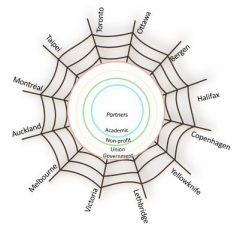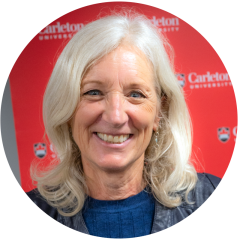About Imagining Age-Friendly Communities
Imagining Age-Friendly Communities within Communities: International Promising Practices builds on the World Health Organization’s (WHO) “Age-Friendly Communities” global initiative. This initiative promotes cities and communities adapting social and physical infrastructure to promote autonomy, and health for aging populations.
Addressing critical knowledge gaps identified by the WHO, Imaging Age-Friendly Communities investigates how culture and gender matter in creating age-friendly cities. Our attention to “communities within communities” across 12 cities in Canada and around the world guides us to account for differences, and a critical perspective on best practices.

Our international comparative methods incorporate ethnographic, survey, policy network, social work, cultural studies and arts-based methods, and will unfold over a seven-year period in communities in Canada, Australia, New Zealand, Denmark, Norway and Taiwan.
This brand 7-year project is funded by Canada’s Social Sciences and Humanities Research Council (SSHRC).
Research Themes
Our research will build on and extend WHO-identified domains by focusing on the following themes:
Policies and Systems
-
- What social, political and economic policies and systems best integrate and coordinate to meet needs and balance the rights of diverse aging groups, the spectrum of paid and unpaid careers, and broader communities across the case sites?
- How are gender and culture implicated?
- How is accountability for services that address diversity enacted?
- How, and to whom, are policy and decision makers held accountable?
Environments, Designs and Technologies
-
- What universal and technological design elements are feasible, desirable and equitable for individuals and their carers?
- How are gender and culture implicated?
- What type(s) of “community” are imagined through supports and technologies that aim to keep seniors at home?
- How does technology impact community, relational and leisure space for aging?
Approaches to Aging
-
- What philosophical, cultural and gendered approaches to aging are most promising for individuals, families, and the spectrum of carers across communities?
- What are the pathways, choices and conditions available to people aging in different communities?
- Who gets to be old, when and where?
Care Relationships: Conditions and Quality
-
- What practices show promise in ameliorating living and working conditions to affect experiences of quality of life, work and care for aging individuals, as well as the range of paid/unpaid carers across settings?
- How can we understand the roles of multi-generational families and impacts of migration?
- How do people navigate transitions in spaces (home, community, institution) and places (jurisdictions)?
- How is quality care for seniors defined?
The Research Team






